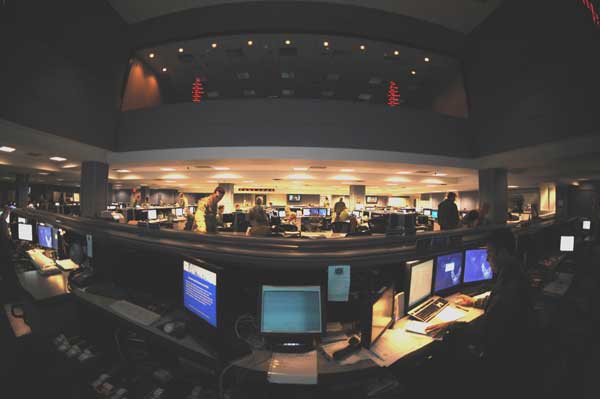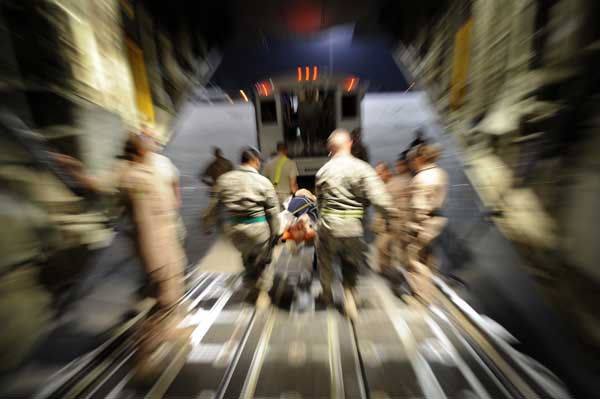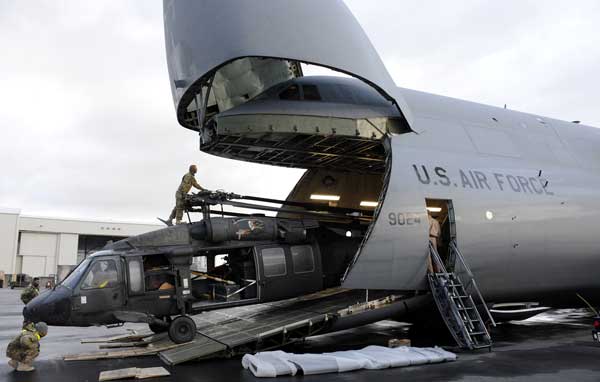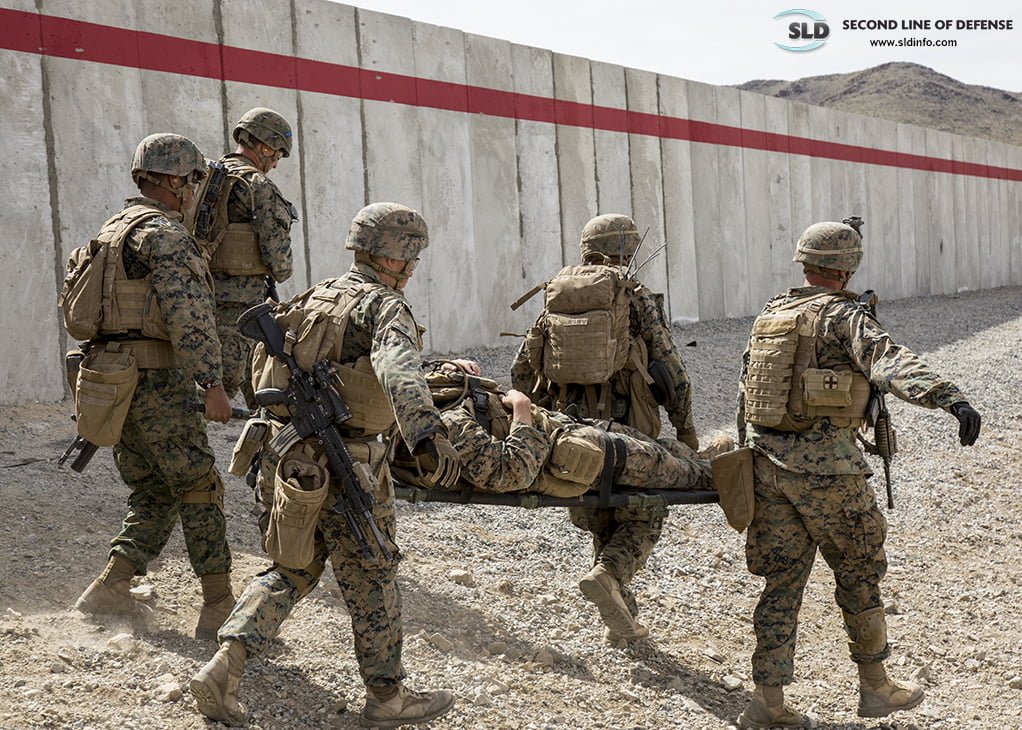A Wrap Up Discussion with Captain Brockhoff
06/16/2011 – After an overview briefing and a visit to the Tanker Airlift Control Center (TACC) command center, Second Line of Defense sat down with Captain Brockhoff to focus on several items highlighted in the morning briefing. Captain Justin Brockhoff is the Chief of Public Affairs for the Tanker Airlift Control Center.
 Operations Floor TACC (Credit: TACC)
Operations Floor TACC (Credit: TACC)
SLD: The argument presented around the table was basically that the C2 capability of the Command gives you an ability to deliver capability worldwide and allows you also to deploy assets up against shifting priorities.
Captain Brockhoff: The same way in your writings on SLD where you talk about the 5th generation capabilities forcing us to radically re-look at our con ops, look at our approaches, the honeycomb vice, the network way of looking at things, the TACC is always looking for ways to maximize the effectiveness of our global airlift, air refueling and aeromedical evacuation operations.
SLD: In the briefing, the team discussed the significant shift in how aeromedical evacuations trans-theater is approached. Could you discuss this shift?
Captain Brockhoff: One of the real changes over the past decade is that we have gone from a dedicated aeromedical evacuation platform, the old C-9 Nightingale, to modular insertion into a wide range of available lifters. We went from one airplane doing that kind of mission to a structure where really any Mobility Air Force aircraft can be converted to be an aeromedical evacuation platform.
Today, primarily, we use the KC-135s and the C-17s, because the equipment in the back end for the air medical evacuation mission can be moved from airplane to airplane. The equipment is not hard built into the airframe itself.
SLD: So the aeromedical evacuation equipment is configured as modules?
Captain Brockhoff: Correct. And they are tailorable modules based on the patient requirements. So if we just have a flight with routine patients, the ones that have to move within 72 hours but do not have a threat to life, limb or eyesight, we’ll usually have a standard aeromedical evacuation crew on that mission. And that usually involves a nurse, two medical techs and two respiratory technicians to care for the patients in flight.
Taking it a step further, if there is a patient that is either a priority patient, they have to move within 24 hours, or an urgent patient who has to move immediately, that’s when we step it up and the patients can require what we call a critical care air transportability team; where we add on a flight surgeon and additional flight nurse and more respiratory and medical technicians. And they’re there to care for that specific patient who is in such a dire circumstance that they need to move immediately.

The flexibility that is provided by being able to use any aircraft in the mobility fleet is extremely helpful because we can use an airplane that’s already in the area instead of being in a situation where the nearest dedicated airplane might be a couple hours away. We can reduce the response time by just converting the airplane that we have available into an aeromedical evacuation mission.
SLD: In the earlier meeting, there was a case study of an army officer who’d been stabbed in the head in Iraq cited as an example of the system operating.
Captain Brockhoff: The case was that of army Sgt. Dan Powers who was on a foot patrol in Iraq and was stabbed by in insurgent with a knife that actually went through his temple about three to four inches into his head. Amazingly, he stayed conscious, and was moved to a field hospital in Balad, where doctors were able to remove the knife from his head.
The next step was Sergeant Powers’ follow-on care. The doctors on the ground determined that he had be moved back to the United States in order to receive that follow on care to sustain the life saving that they had already done. From the TACC perspective, we got involved as soon as the doctor said this person needs to fly straight from Iraq back to the US.
The first step by our aeromedical evacuation experts on the operations floor was to see was what assets were available. And since we can reconfigure almost any mobility aircraft to fly an AE mission, we found a C-17 that was relatively near to Balad, and we re-tasked the air crew from a cargo mission into Afghanistan to move Sgt. Powers from Balad back to the US.
Within three hours of getting the call at the TACC, and because of the flexibility that we have, that aircraft arrived to Balad, and was reconfigured by adding all of the equipment for the aeromedical evacuation mission. Sgt. Powers was loaded on the aircraft shortly after it was reconfigured, and they were airborne.
At the same time, the doctors placed a restriction on the mission because of the pressure that was involved with Sgt. Powers head injury. The C-17 was going to be limited to about 27,000 feet, and since it was already a long flight anyway, we knew a non-stop trip would require air refueling.
Our tanker cell on the operations floor contacted the tanker unit in the UK where the Air Force has KC-135’s and we coordinated with them to launch one of their KC-135’s that met up with the C-17 over the Atlantic to provide in air refueling.
The result was that Sgt. Powers wheeled into the hospital room in the Washington D.C.-area in under 20 hours from the point that we got the phone call.
SLD: And the result ultimately was that Sgt. Powers returned to his unit; and celebrated his return to his unit by joining a parachute jump. The case of Sgt. Powers certainly highlights personal courage and team support. The best of what the U.S. military brings to the table. Also discussed at the briefing was a good example of the fuel savings of the M vs. the C5-A. Would you go back over that?
Captain Brockhoff: That involved what we call a multimodal operation. In this case it was rotating a combat aviation brigade and their helicopters into Afghanistan to replace their sister brigade that was re-deploying back to the U.S.
The trip started with about a hundred army helicopters being loaded onto ship here in the U.S. The ship then went to a location in Western Europe where the helos were offloaded from the ship and transloaded onto C-5’s. We had two C-5 M’s and two C-5 B’s dedicated to this swap out.
From there, once the helicopters were loaded onto the C-5s in Europe, the aircraft would fly to Afghanistan where they would offload the in-coming helicopters and then onload the ones rotating out.
After that swap out in Afghanistan, the C-5 B’s would have a scheduled fuel stop in Iraq on the way back to the operating location out of Western Europe. But the C-5 M’s, because of the newer engines were able to over fly that fuel stop that was required for the B’s.
(For a discussion of the C-5M see https://sldinfo.com/?p=3483).
 Soldiers spot a UH-60L Blackhawk while it is being loaded onto a C-5 Galaxy, Mar. 2, 2011, at Kandahar Airfield, Afghanistan. The Blackhawk upload was part of a change out; the old helicopters are being replaced by new airframes. (Credit: USAF, 03/02/2011)
Soldiers spot a UH-60L Blackhawk while it is being loaded onto a C-5 Galaxy, Mar. 2, 2011, at Kandahar Airfield, Afghanistan. The Blackhawk upload was part of a change out; the old helicopters are being replaced by new airframes. (Credit: USAF, 03/02/2011)
SLD: One more thing would which you mentioned was what I will call the self-healing maintenance system. The fact that you have within the system the ability to get information about folks maintaining your fleet, who can be requesting parts and then you can actually schedule the parts to go out to where ever the location is. Could you just go back over this?
Captain Brockhoff: On our operations floor, we have a dedicated cell of maintenance experts. Here at the TACC, they’re all senior NCO’s; so they are very experienced maintainers themselves who have either seen the issue or the guy next to him has probably seen the issue that whatever the maintainers actually fixing the airplane are facing.
For example, let’s say we have an aircraft at Bagram Air Base in Afghanistan which needs repair. The maintainers on the ground are the primary guys to work the issue, but through the command and control systems and direct interaction through phone call they report to us what the problem is, when they think the airplane’s going to be fixed, and importantly any parts or additional maintenance personnel that they’re going to require to fix that airplane.
If there is a need for additional parts or maintenance personnel, from the TACC, we can look into the system and see where the nearest part is located, we’ll say for example it’s at Ramstein. From there we can reserve a pallet position on the next available mission going from Ramstein to Bagram, and now we have a pallet position to put that part or that maintenance team that needs to go forward.
And then we put it on the aircraft, get it to where the part and the people need to be to make a difference to fix that airplane and because of that command and control structure we have from here, in over 90% of the cases, our aircraft are fixed within 48 hours.


